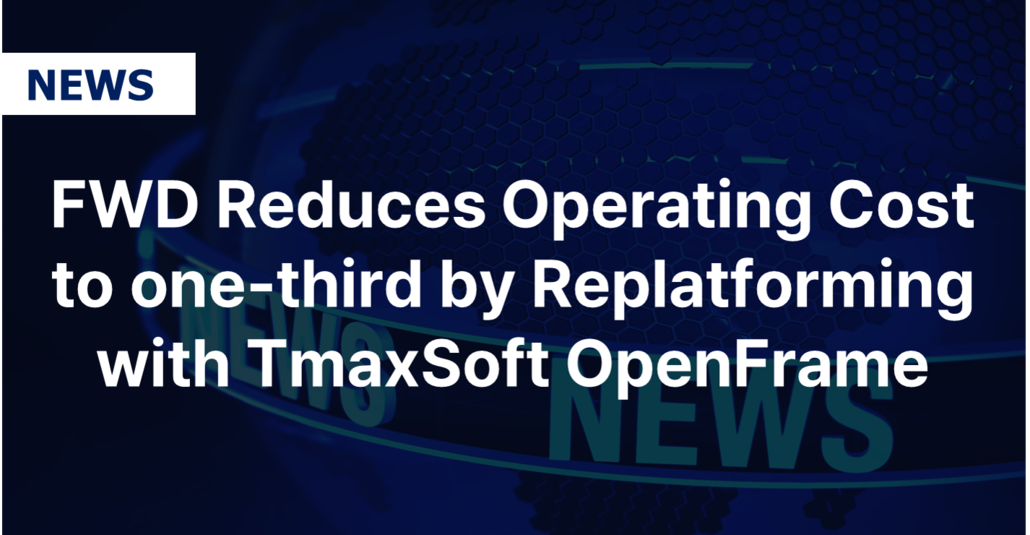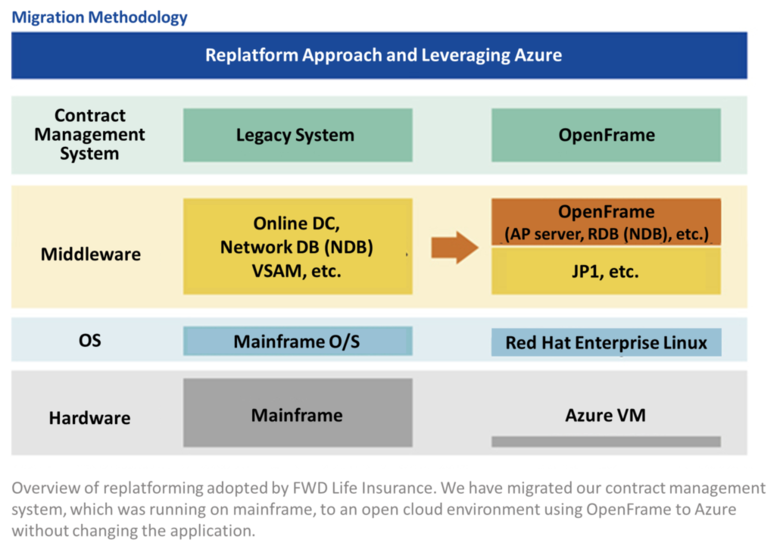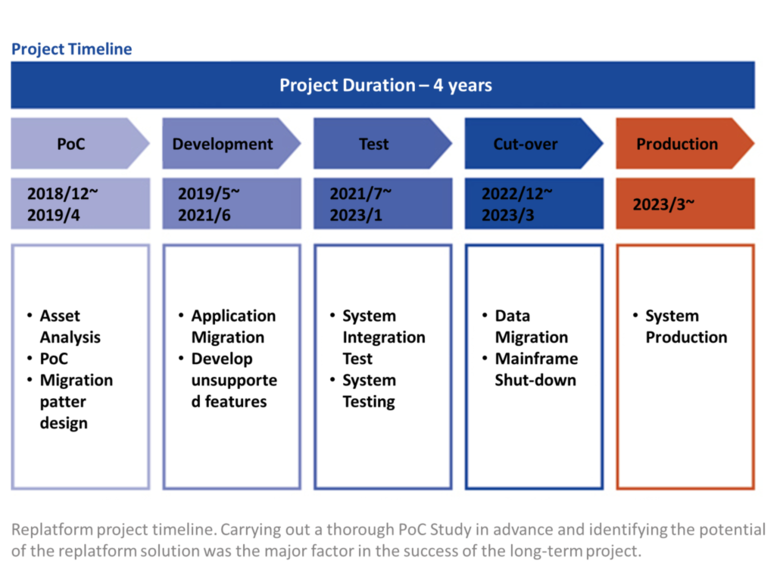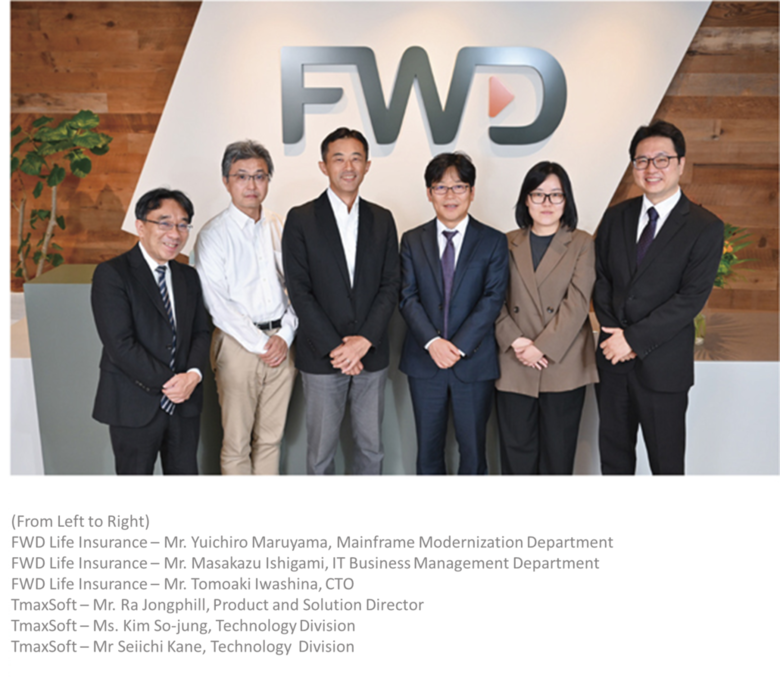Blog / News
- HOME
- About
- Blog / News

FWD Life Insurance has been providing life insurance in Japan for over 27 years and is highly regarded by customers and other organizations. The company’s Contract Management System, which was on the mainframe, has been in use since 1996, when the company was founded. The discovery to replatform the system started late 2018, and the migration was completed in March, 2023. Microsoft Azure, the cloud platform of choice for the FWD Group, was selected as the foundational infrastructure for the project, along with Tmaxsoft “OpenFrame,” which quickly migrates mainframe application assets and data to the cloud environment while providing for the stability and availability on Azure equivalent to the mainframe. Replatforming helps reduce operational costs by one-third, while providing sufficient availability. The company can now consider the conversion of applications to microservices and the full-scale implementation of agile DevOps.
Choosing Replatform for low-risk migration from high-cost and complex mainframes
FWD Life Insurance Co., Ltd. (hereinafter referred to as FWD Life Insurance) has been providing life insurance in Japan for more than 27 years and currently has over 1.86 million contracts. Also January 2023 Oricon Customer Satisfaction ® In the survey released on the 4th, FWD Income Guarantee was ranked in the Income Guarantee Life Insurance Product Ranking I was selected as number one for the third consecutive year. HDI, the world's largest support services industry membership organization, is based in Japan “The HDI-Japan benchmark” “Quality Rating (Center Rating: Phone)” also received the highest rank of “Three Stars” in fiscal 2023, which is highly regarded by customers and third parties."
What is noteworthy about the company's IT system is that it has replatformed its "contract management system," which is an important infrastructure that supports its business, from the domestic mainframe that it has been using for many years to the cloud. Replatforming is a method of changing the OS and hardware that run business applications without making any changes to them.
“We have been using mainframes since the first introduction in 1996, but around 2017 we decided it was time for a new infrastructure,” says Mr. Tomoaki Iwashina, Head of IT Developments & Planning of FWD Life Insurance, where he is Head of IT Developments & Planning. He recalls that he was already acutely aware of the problems faced by mainframes since its introduction.
"Our previous contract management system outsourced everything from hardware installation and management to day-to-day operations to the mainframe vendor. This resulted in high costs and increased complexity of the system itself. Also, support from mainframe vendors was beginning to decline around this time, which made us feel the need to migrate to a new infrastructure."
Therefore, in May 2017, as part of a new IT strategy, we began building a new contract management system for new insurance products. When this was completed in September 2018, the old contract management system running on mainframe was used only for managing old products. In other words, contract management systems running on mainframes were in a state of being almost ‘stuck.’ These changes in system configuration were also a strong factor in pushing away from the high cost and complexity of domestically produced mainframes.
After that, we began full-scale consideration of infrastructure migration of the old contract management system. Initially, we considered integrating it with the new contract management system completed in September 2018, but it would be difficult to comprehensively address the differences in specifications between the two contract management systems, and there was also the problem of high risk due to the huge amount of assets.
“The IT assets that needed to be migrated from the old contract management system were over 19,000 programs, 237 databases, and 45 related systems. We decided that replatforming was the best way to move away from this. Furthermore, since the FWD Group is fundamentally cloud-first, moving to the cloud was a natural choice.''
Adoption of TmaxSoft's replatforming solution "OpenFrame" - Migrating critical systems from mainframes while fulfilling limited migration schedules and industry-specific needs –
In parallel with these considerations, we also selected a platform product for replatforming. After comparing and considering multiple replatforming solutions, we decided to adopt "OpenFrame" provided by TmaxSoft. Mr. Iwashina explains the reason as follows.
“There were other solutions that could replatform from IBM mainframes, but OpenFrame was the only one that had a track record of migrating from domestically produced mainframes. Being able cover a wide range of mainframe features was another reason for choosing it."
Azure is the foundation for running OpenFrame. He explains that the FWD group adopted Azure as a common platform worldwide and was able to evaluate its performance, reliability and cost-effectiveness.
“We have successfully completed many mainframe to Azure migration projects, and in 2020 we collaborated with Microsoft’s Chief Architect Team to migrate batch and online workloads with OpenFrame to Azure. OpenFrame on Azure demonstrated better performance and scalability than System Z infrastructure. This has enabled us to confidently meet our customers' needs. ” said Mr. Ra Jong-pil, TmaxSoft Product & Solutions Director.

We started Proof of Concept (PoC) in December 2018, and first took an inventory of mainframe assets to be migrated and verified the operation of some features on OpenFrame. From among the applications to be migrated, we selected processes that allowed us to comprehensively check the functionality of OpenFrame, and ran them on OpenFrame to confirm that there were no unforeseen problems.
"I was involved in this POC, and I checked that data registration, inquiries, and updates all worked without problems," said Mr. Ra. The old contract management system uses a network type DB, which is converted to RDBMS by OpenFrame, but in this conversion process, OpenFrame provides a special interface, so it is unnecessary to modify the COBOL application. He also explains that since the data has been migrated to his RDBMS, the integration with Oracle DB is done through the Change Data Capture (CDC) solution provided by TmaxSoft. “Individual data handled in the insurance industry has large record sizes, and existing data types are often redefined to use the data in other operations."
The POC was completed in April 2019, and the full-scale project began the following month. It took us about two years to build an environment that would allow us to migrate the vast number of applications mentioned above. Testing began in July 2021, and migration began in December 2022. The migration was completed by March 2023 and live for production in the same month.

Considering “microservices” as the next initiative
The project period is approximately 4 years. Although this was a long-term project, Mr. Iwashina says that from the beginning he kept three things in mind when moving forward with this project. He decided to conduct a thorough POC before officially selecting a vendor to determine the potential of the solution, choose a reasonable method of replatforming to break away from dependence on mainframe vendors, and since it is difficult for a single company to succeed alone, work together with multiple partners that can ensure a successful project. As a result, FWD Life was able to successfully break away from mainframes.
“As a result, system operating costs have been reduced to one-third,” says Mr. Iwashina. What I was concerned about was availability, but he says that there have been no failures related to business logic in the six months since the start of production. He also points out that since the infrastructure is cloud-based, resources can be quickly increased when processing volume increases, which is a source of operational security.
By moving to the cloud, we were able to do the operations in-house, which has also been praised for increasing the transparency of our operations. This means that when a problem occurs with the system, we can respond more quickly than before.
In addition to these, Mr. Ra says, “Since the data is converted into an RDB, the possibilities for data utilization are far greater by linking it with various cloud-native features provided on Azure. We also offer migration solutions and can help you move away from COBOL.”
With the sunset of the mainframe that weighed down the system, the hurdles for new initiatives have suddenly become lower. Mr. Iwashina says that he already has two objectives in mind.
One is application microservices. Some systems have already commenced, and full-scale implementation is expected to begin next season.
The other is improving system development speed and productivity by introducing Agile/DevOps. This has also been applied in some systems, but he plans to move forward with full-scale deployment from next fiscal year as core systems become more stable and lower in cost.
“I think we will start with a front-line system for customers, but in the future we are also considering turning contract management-related functions into microservices,” says Mr. Iwashina. He said that the move away from mainframes with Azure and OpenFrame has an important meaning in taking the next step in IT strategy.

The content of this case study refers to the information available at the following URL on Microsoft Japan's website.
Please note that the content may be subject to change, and for the latest information, please refer to the following link:
https://customers.microsoft.com/ja-jp/story/1703872936898754933-fwdlife-azure-insurance-jp-japan
